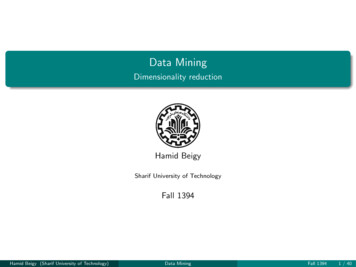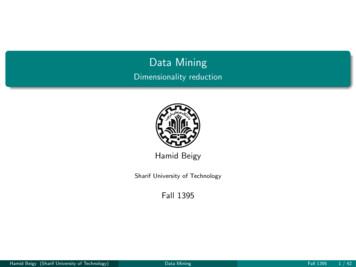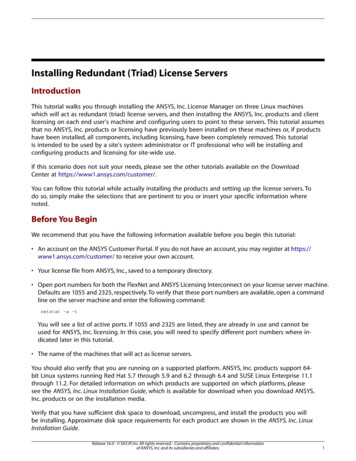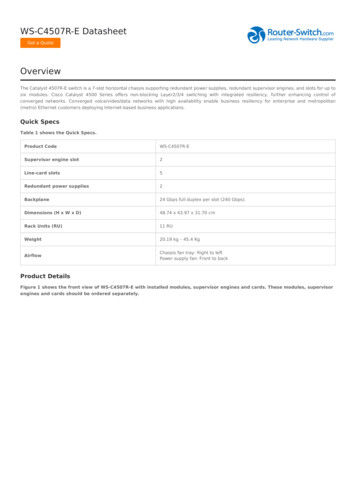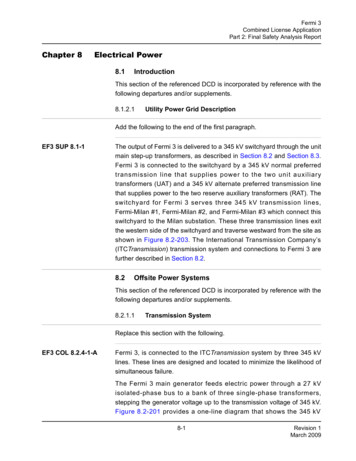
Transcription
COREMetadata, citation and similar papers at core.ac.ukProvided by AIS Electronic Library (AISeL)Association for Information SystemsAIS Electronic Library (AISeL)ECIS 2012 ProceedingsEuropean Conference on Information Systems(ECIS)5-15-2012UNDERSTANDING METHODS TOREDUCING REDUNDANT MEDICAL LABTEST ORDERING ? A CASE STUDY ONVISTA/CPRS AND THE VETERANS HEALTHADMINISTRATIONLorie ObalVeterans Health AdministrationSamir ChatterjeeSchool of Information Systems and TechnologyLeonard KleinmanGreater Los Angeles Veterans Health AdministrationFollow this and additional works at: http://aisel.aisnet.org/ecis2012Recommended CitationObal, Lorie; Chatterjee, Samir; and Kleinman, Leonard, "UNDERSTANDING METHODS TO REDUCING REDUNDANTMEDICAL LAB TEST ORDERING ? A CASE STUDY ON VISTA/CPRS AND THE VETERANS HEALTHADMINISTRATION" (2012). ECIS 2012 Proceedings. 230.http://aisel.aisnet.org/ecis2012/230This material is brought to you by the European Conference on Information Systems (ECIS) at AIS Electronic Library (AISeL). It has been acceptedfor inclusion in ECIS 2012 Proceedings by an authorized administrator of AIS Electronic Library (AISeL). For more information, please contactelibrary@aisnet.org.
Understanding Methods for Reducing Redundant Medical LabTest Ordering – A Case Study on VistA/CPRS and the VeteransHealth AdministrationObal, Lorie Claremont Graduate University, School of Information Systems andTechnology, 130 East Ninth Street, Claremont CA, 91711, lobal55@gmail.comChatterjee, Samir, Claremont Graduate University, School of Information Systems andTechnology, 130 East Ninth Street, Claremont CA, 91711, Samir.Chatterjee@cgu.eduKleinman, Leonard, Greater Los Angeles Veterans Health Administration, 11301Wilshire Blvd. Los Angeles CA 90073, Leonard.Kleinman@va.govAbstractReducing redundant medical lab tests has been discussed in the literature as a cost saving benefitof Electronic Health Record (EHR) adoption; however the literature does not provide a greatdeal of information on the mechanics of achieving this goal. Laboratory ordering using an EHRoccurs within a complex socio-technical context that can be difficult to understand. A case studywas performed on an EHR that provided insight into the interplay of these elements as well as thecurrent state of laboratory ordering guidelines. A theoretical framework, including the Principleof Good Enough (POGE,) for technology design was used to guide the research. The resultimproved insight into required technological capabilities to support clinical care and theenvironmental contexts that shape them.Keywords: Electronic Health Records, Structuration Theory, Open Source
1. IntroductionHealthcare is a very information intensive discipline. Current paper-based systems are becomingdysfunctional in light of evolving demands. Electronic Health Record systems (EHRs) arecurrently being sought as the solution to problems in health information integration, efficiency,dissemination and storage by various healthcare organizations (IOM, 2001).Although many healthcare facilities have some computerization to varying degrees, few haveattained fully integrated systems that are able to exchange data across facilities. One of the mostnotable exceptions has been the Veterans Health Administration (VHA) and its VistA/CPRSsystem. VistA/CPRS supports 155 medical centers and over 1400 centers of care. Vista/CPRS isan open source, publicly available EHR that has been adopted outside the VHA by otherhealthcare organizations in the US (Maduro, 2007b) and in other countries (Maduro, 2007a). Asan organization, the VHA has had extensive experience and opportunities for “lessons learned”from developing, using and maintaining electronic health records.Results management and reducing redundant lab testing is one of the core functionalities for anEHR specified by the Institute of Medicine (IOM) as a potential cost saving benefit of EHRadoption (IOM, 2003); however the literature does not provide a great deal of information on themechanics of achieving this objective. This study focused on analyzing the issues and contextsthat shape lab ordering problems as well as key technological capabilities supporting thishealthcare function within the VHA.2. The problem of redundant lab ordersOne reason physicians may repeat laboratory orders are simply because previous results cannotbe found. In paper based hospital records, a single patient record may span several boundvolumes all of which might not be immediately available because they are in the hands ofdifferent healthcare providers. Immediate and simultaneous accessibility are basic advantages ofan EHR over paper records. This also reflects the preference for “everything being in one place”that was cited by several physicians interviewed for this study.According to the literature on medical cost containment for laboratory ordering, different types ofinterventions have been tried with varying levels of success. Educating physicians on lab testcosts has shown some short-term improvements (Stuebing and Miner, 2011) ; however thesebehaviours have been observed to drop off over time (Eisenberg and Williams, 1981) orotherwise not to be an effective cost containment strategy (Schroeder et al., 1984). Eisenberg andWilliams (1981) concluded that, with special emphasis on outliers – physicians with significantlyhigher levels of laboratory orders - feedback was an effective mechanism. However, the auditingand reporting mechanisms of the day incurred their own costs and thus diminished the total costsavings (Eisenberg and Williams, 1981). The improved access, reporting and data visualizationcapabilities of VistA/CPRS, presents a new opportunity to examine redundant lab orderingproblems and possible solutions.3. TheoryThe relationships between healthcare information systems and clinical practice comprise acomplex socio-technical environment. The context of the healthcare environment as well as theIT artifact requires study, the latter of which tends to be under theorized in the literature(Greenhalgh et al., 2009, Greenhalgh and Stones, 2010). Clinician behavior as well as functional
properties of the healthcare record interacts within the healthcare organization and its regulatoryenvironment. Quantitative methods may be insufficient to understand the interplay of recursiverelationships between a healthcare organization and its technology (Kaplan and Duchon, 1988)(Kaplan, 2001). Kaplan and Duchon (1988) have noted that many uncontrolled and unknownvariables occurring in complex social systems are problematic when using quantitative methodsin natural settings. The reductionism needed for quantitative experiments may reduce theresearch question to the obvious and sacrifice a deeper understanding of the phenomenon (Kaplanand Duchon, 1988). Therefore, a qualitative case study methodology was used in conjunctionwith a theoretical framework to provide contextual reference to technology supporting laboratoryordering and clinical records.Structuration Theory, developed by Anthony Giddens (1984) provides an explanation of thereproduction of social systems through social actions (Giddens, 1984). This theory has beenextended in Information Systems (IS) research to include the element of technology and thereciprocal effects of human interactions with technology (Orlikowski, 1992). This theoreticalorientation provides advantages for studying the interplay of the EHR (VistA/CPRS) and theclinicians of the VHA. VistA/CPRS was built from within the healthcare organization of theVHA. As such, it is the result of the internal constructs of the participants – the clinicians who useit – and “constitutes a [mode] of human practice” as described by Structuration Theory(Orlikowski, 1992).While Structuration Theory is a useful basis for describing the interactions of social structureswith technology (Orlikowski, 1992), a framework by Greenhalgh and Stones (2010) was adaptedto provide more theoretical focus on the technology component (Greenhalgh and Stones, 2010).Their framework using “Strong Structuration Theory” utilizes conceptual components todifferentiate properties of the technology artifact within the network of human technologyinteractions including integration of principles taken from Actor Network Theory (ANT) (SeeFigure 1).VistA/CPRS has been described by physicians in the VHA as having achieved a “Good Enough”level of functionality. This provided the opportunity to further structure the analysis by adding the“Principle of Good Enough” (POGE) in software design as an element of the analysis framework.As proposed by Yourdon (1995), POGE proposes the rational that “good enough”, rather thanoptimization of all software properties can be a desirable goal, particularly in the commercialsector where economic realities are often their final determinants of software quality (Yourdon,1995). The resulting focus for the study can be seen in Figure 1 where the framework of StrongStructuration Theory (SST) developed by Greenhalgh and Stones (2010) has been adapted toinclude the lens of POGE with which to examine the technology artifact.
Figure 1.Strong Structuration Theory by Greenhalgh and Stones (2010) adapted with theadded focus of the Principle of Good Enough (POGE).3.1 The Theoretical Lens – the Importance of ContextContextualizing healthcare using an EHR is particularly important, given the highly regulatednature of healthcare and the influence of policy making institutions including a current emphasison government subsidies for health IT. Healthcare organizations in and of themselves arecomplex entities. This backdrop is important as it affects the interactions of clinicians and theEHR.Strong Structuration Theory (SST) provided a method both for examining and describing theseforces. While SST includes principles taken from Actor Network Theory (ANT), it includescaveats regarding the frequent objections to ANT such as the perception of symmetry betweenpeople and technology in the network of interactions between the two. SST also accepts thatsocial order can be inscribed in and magnified by technology; however the limits of this should berecognized. Finally, SST emphasizes the recursive shaping of the socio-technical network, butrejects reducing human factors to network effects. Instead, SST utilizes conceptual components to
differentiate properties of the technology within the network of human technology interactions(See Figure 1, elements 2c and 2d).Placing these elements in context includes the external structures (Figure 1, level 1) described asMacro, Meso and Micro (Greenhalgh and Stones, 2010), respectively the oversight branches ofthe US government and healthcare monitoring agencies such as the Joint Commission on theAccreditation of Healthcare Organizations (JCAHO), National Committee on Quality Assurance(NCQA), National Institute of Health (NIH) and Centers for Medicare and Medicaid (CMS). Alsoincluded are professional practice organizations affecting healthcare delivery such as theAmerican College of Physicians (ACP), American Medical Association (AMA) and finallyfacility level regulations and guidelines.Level 2 of Figure 1, provides focus on theorizing human factors including the “instantiation” and“appropriation” of technology (Greenhalgh and Stones, 2010) (Figure 1, elements 2a-2d). For thisresearch, POGE was applied to the level 2 elements to improve focus on the essential technologyelements. Level 3 of Figure 1 is used to examine the interplay of action and agency between theclinician’s knowledge and situations that interplay with the EHR. This framework level wasproposed to answer criticisms of ANT in that elements of human and technological interaction areunder-theorized (Greenhalgh and Stones, 2010).Level 4 of Figure 1 is for describing the outcomes of the socio-technical interactions onhealthcare delivery including unintended consequences or “E-Iatrogenesis” (Koppel et al.,2005b). For this research, outcomes reflect care delivery effects rather than patient outcomes.This includes co-opting the EHR to perform functions not part of the original design. A benefit ofthe approach is to gain a reference point for examining the current evolutionary effects resultingfrom the interplay of the socio-technical system.A summary diagram was created to illustrate the convergence of the guiding theory and datasources used (See Figure 2). This diagram was used as a mental reference during data collectionto help identify the flow of dynamic elements in the socio-technical environment.
Figure 2.The Research Framework and Issues Related to Redundant Lab Ordering4. MethodologyThe research activities were divided into three primary phases:1. Background analysis of VHA generated documentation2. A focus group interview3. Individual InterviewsIn addition, documentation from the Institute of Medicine (IOM) with specifications of requiredcapabilities for EHRs (IOM, 2003) was used as a baseline comparison to VHA specifications onVistA/CPRS, the VistA Monograph (VHA, 2008-2009). IOM specifications and VistA/CPRSproperties were mapped in a side-by side comparison using open source software for cognitive
mind-mapping. This was to test the comprehensiveness of VistA/CPRS as an EHR. Thiscomparison was used to fulfil the requirement to define external structures driving EHRspecifications (See Figure 1, box 1). The three phases of data collection followed the principlesof case study methodology prescribed by Yin (1994). This methodology includes convergence ofmultiple sources of evidence and investigator triangulation of data in the analysis process (Yin,1994). In this study, the sources of evidence used for triangulation included multiple types ofVHA documentation on VistA/CPRS and interviews with VHA clinicians. Interview subjectswere chosen for their expertise on different VistA/CPRS capabilities.The three phases occurred in sequential order. In the first phase, analysis of VHA documents wasused to develop major categories for further investigation. Due to the enormous scope of theVHA and its use of an EHR, the background documentation was analyzed to limit the researchscope to a smaller number of specific categories. The documentation that was analysed includedfunded VHA improvement initiatives (Greenfield projects), VHA documentation on continuingtechnical work and improvements being made to VistA/CPRS and the results of a VHA conteston “Top 100 Innovations”. The latter was a contest wherein VHA employees suggested and votedon ideas to improve the EHR and other aspects of healthcare delivery. For this research only thesuggestions directly pertaining to the EHR were used.During phase one, the documentation was analyzed using Atlas.ti software to identify recurringconcepts using grounded theory approach of coding text to develop conceptual categories (Straussand Corbin, 1990). These categories guided the subsequent qualitative interviews in phases twoand three. This process was applied at each phase to determine points of data triangulation.In phase two, the focus group was conducted using the key concepts identified in phase one as aguide for more in depth investigation and to determine if any new categories emerged. This wasthen followed by phase three in which topics developed in phases one and two were examined indepth with subject matter experts. During this iterative process, the organizational goal to reduceunnecessary testing (redundant lab ordering) emerged as a concern. This topic was investigated inmore depth during interviews with a clinical subject matter expert.4.1 Research SubjectsQualitative data was collected through a focus group with 12 participants and six individualinterviews. The focus group consisted of 6 M.D.s, (5 male, 1 female) 6 Nurses (5 female, 1 male).The individual interviews were with 4 M.D.s (2 male, 2 female) and 2 nurses, both female. Theinterviews were conducted with individuals who were very knowledgeable about the EHRproperties determined to be key points for the study. The participants were interviewed usingsemi-structured questions. These results including possible solutions are presented in the nextsections.5. Improving feedback mechanisms for cliniciansAs discussed under section 2, earlier attempts to control redundant testing were difficult due tothe lack of integrated EHR systems with good reporting mechanisms. With VistA/CPRS, dataextraction has become more efficient and it is possible to generate physician report cards onlaboratory utilization. Clinical Dashboards that provide summary reports on EHR data extractsare currently being developed at the VHA. Currently, they are used to help physicians monitor theoverall patient outcomes for their assigned patient panels. For example, they can see on average,how well their diabetic patients are maintaining their glucose levels. A physician was askedwhether the Clinical Dashboards have been used to address test ordering issues:
“So, some of it is cultural probably. I mean I would think that one way to avoid redundant testordering would be to provide feedback to people on outliers. Like, you know, you’re an outlierfor CBCs. Like, compared to the average provider, with the same number of patients on theirpanel, you know, you’re ordering - you ordered 20% more CBCs per year Report cards on thatmight be something that could help.”As can be inferred from the above, the “culture” of the practice of medicine, including physicianautonomy, is part of the socio-technical fabric surrounding replicated lab ordering. Feedback is apassive method to elicit voluntary provider change – assuming there are no organizationalsanctions based on the reports.6. Control Mechanisms and Physician BehaviorA more direct method to prevent redundant orders is to provide physicians with a warning. Thismethod is subject to the same alert fatigue problems described elsewhere in the literature(Koppel et al., 2005b, Koppel et al., 2005a, Kyle et al., 2010). As described by a Physician:“ There’s a functionality that allows you to warn someone, to warn them that they’re ordering aduplicate study – meaning that there’s already an existing lab order for it or the study’s beenresulted. So Lab has the ability to try to prevent you from ordering unnecessarily frequentlabs. So how well does that work? Well, [name omitted] said the providers just override it. Part ofit is probably just alert fatigue. Part of it is that it might not display to you the result, and the exactdate that it was done.”The presence of an EHR at the VHA creates the opportunity to explore new mechanisms for costcontrol beyond those commonly found in the literature. The EHR is generally thought of as a toolto introduce efficiency in healthcare; however it is conceivable that using it as a means tointroduce inefficiency could be used as a cost control method. These methods include: Removing items from the menu – force use of more laborious process Require additional levels of review or approval Require more information to process order Full-stops on ordering processAccording to one subject, full-stops for attempting to order a lab are not in place. “There are nofull stops on lab tests – not for the routinely ordered ones. I mean certainly there are send outlabs, where there’s more oversight just because they’re more expensive, but for your routine labsthat we can run in our system? No - there’s no stops.”Using more active methods can introduce new tensions into the socio-technical environment withregard to physician autonomy. As explained by a research subject, there can be clinically justifiedexceptions that do not fit the algorithm requiring an override and various follow-up processes toensure patient safety. In contrast, for the medication order check, the basic functionality supportsa more conservative approach. The preferred error is to be overly cautious, that is, to prevent anaction.However, laboratory ordering is a different case. Lab results provide the clinician withinformation to support clinical decision making and as a safeguard for patient care. Therefore,setting prohibitory conditions on lab orders can be more difficult to justify. In these cases, the
override is to maintain patient safety. This question was corroborated by a physician: “ that’swhy that’s a warning system, you’re allowed to override it.”7. Lack of Evidence Based Guidelines to Reduce RedundantTestingWhile the EHR can be used to directly intervene in lab ordering practices, the medical literaturehas not developed clear, evidence-based guidelines for developing the necessary algorithms.There are many potential clinical justifications for repeat ordering. A Physician explained thatcurrently there is not a great deal of evidence in the medical literature to determine optimalfrequencies for lab ordering:“Like what’s the next set of tests – what parameters should we put around ordering some of theseother tests? Like how frequently should a patient get an ANA tested? It’s an anti nucleotic –serology – that you use to assess for Lupus or something like that. If the ANA’s negative – it’snot going to turn positive you probably wouldn’t have to order an ANA - ever order it morethan once a year if even and you would probably never order it if it’s negative, it’s almostalways negative unless the patient really developed some full-blown symptoms. It’s a funnything. So, but you’d have to sit down with the clinical experts and work out the parameters forthose. I don’t think anyone has done that1.”EHR development in this area may have to be postponed until there is more evidence to guidealgorithms for lab testing controls in the EHR. Other problems related to improving costeffectiveness of laboratory testing is a lack of data on the cost effectiveness of diagnostic andtherapeutic services (Eisenberg and Williams, 1981). Exceptions to standard guidelines occurwhen a physician must give a medication despite there being contraindications and therefore,must follow the patient with more frequent testing.While, the availability of labs in the EHR can help to avoid redundant tests by making the resultsmore retrievable, finding the pertinent data within an ever growing patient record can workagainst the efficiencies of “having everything in one place”. A Physician described the need toimprove the presentation of relevant data: “Rather than now if I have a diabetic and I’ll look atthe notes I’ll see what’s been done and then I have to go look at the labs, and then I have to go tothe consult to see if an eye exam was done. If I’m smart enough I’ll look at the reminders to lookat that stuff – there’s lots of places you have to look.” More work is necessary to determinewhether improving the search capability and presentation of data will be preferable to developingalgorithms to reduce lab redundancy.8. Continuing Development of the EHRThe VHA is currently developing the next-generation of VistA/CPRS. A Physician was askedwhat would be some of the most desirable elements to help prevent redundant ordering:“So I think the goal of the next generation, is to have a screen that will sort of – when you open itup to the patient, you get a snapshot of the relevant things for that patient. And I think that byhaving that kind of a view - probably go a long way to avoiding redundancy. Because youwouldn’t specifically have to look for stuff – you know it would be there for you.”Suggestions for improving the presentation of data are not surprising and are consistent withcomments made by other physicians for notifications and alerts. Although the data is readilyavailable in the EHR, large volumes of clinical notes and reports are making it increasinglydifficult for physicians to find what they are looking for. It is also notable that the physicians1This observation may be limited to the local facility as opposed to the entire VHA.
interviewed have tended to suggest view-ability and accessibility over EHR-generated controlmechanisms as remedies for increasing complexity.A physician pointed out that waste related to lab ordering may be as much a problem related toclinical guidelines as redundancy. A suggestion was made to use improved decision support as amethod to combat the problem:“I think moving toward specialized menus for ordering some of the more complex things,that’s in the future, in order to order this you have to go through - you have to come to thismenu and – to order this test. And so by using sort of menus that drive you through a decisiontree, OK, I think that you’ll get better results at the end. So that’s something that we’re going tostart working on. For some of these more complex and expensive tests, where it’s not as clearwhy they should be ordered. Trying to send people through a decision tree that helps to determinewhether it’s really necessary to order - so it’s not really redundant test ordering, its unnecessarytest ordering.”The problem of redundancy and waste in lab ordering is a more complex issue than recordkeeping and data availability. A lack of clear evidence and guidelines in the medical literatureadds to the confusion as to what constitutes appropriate test frequencies. The complexity of thelab tests may require additional decision support provided by EHR algorithms. This is an areawhere outcomes data generated by the EHR can be part of a feedback process to generate futureEHR design.9. DiscussionThe research results contextualized by the framework illustrate the need to improve displaycapabilities and clinician feedback as tools for combating redundant lab ordering. This isparticularly useful information given the problems with using control mechanisms and clinicianeducation to regulate this clinical activity. The lack of clear evidence based guidelines for labreporting frequencies and the required flexibility for justified exceptions, suggests improvedvisualization and decision support tools may be a preferable solution. Due to the increasing sizeof individual medical records, improved search ability will also be an important part of datapresentation.While the introduction of deliberate inefficiencies may provide a more active level of control, theeffects on clinician autonomy and knowledge (Figure 1, items 2a and 2b) will introduce newtensions in the socio-technical network. This may also undermine the traditional role ofconsultations with clinical specialists (Table 1, item 2 a-b) that would be detrimental to safetychecks in the care process.The EHR is able to support record keeping in an accessible manner for physicians. This basicretrievability of results data helps prevent waste. However, optimizing laboratory utilization is amore complex issue involving interactions between professional disciplines and requires a clearset of guidelines to govern test ordering. In this EHR study, we have seen the socio-technical useof the EHR can be used to drive the physician to seek the approval of a human gatekeeper inorder to carry out an action. This raises questions regarding the human engineering that may beneeded to optimize utilization efficiency. Perhaps reallocation of human checks and balances thathave been a traditional part of healthcare will be part of the EHR design solution.Strong Structuration Theory provided a disciplined methodology for iteratively examining avariety of primary and secondary sources of data. SST facilitated examination of both the externalfactors shaping requirements for EHR capabilities as well as the knowledge and dispositions ofclinicians who interact with the technology. The explicit subdivision of internal structures intoboth human actions and properties of technology enabled an additional level of focus on
minimum or “good enough” EHR properties. The focus on best effort delivery is more closelyaligned with the current state of VistA/CPRS capabilities.An additional advantage of Strong Structuration Theory is the inclusion of the principles of ActorNetwork Theory while rejecting the view that people may be viewed as equal or even passiveparticipants in interactions with technology. The latter aspect is particularly important for thestudy of healthcare systems since individual clinical judgement is required when there are still noevidence based practices to guide development of rules for EHR systems. Physicians still retainthe right to autonomy and use of personal judgement in clinical practice. Acknowledgement ofhuman effects on socio-technical networks is relevant when studying home-grown EHRs such asVistA/CPRS since VHA clinicians directly affected both the initial design as well as continuingdevelopment.
ReferencesEisenberg, J. M. & Williams, S. V. (1981) Cost Containment and Changing Physicians' PracticeBehavior - Can the Fox Learn to Guard the Chicken Coop? JAMA, 246.Giddens, A. (1984) The Constitution of Society: Outline of the Theory of Structuration, Berkeley,University of California Press.Greenhalgh, T., Potts, H. W. W., Wong, G., Bark, P. & Swinglehurst, D. (2009) Tensions andParadoxes in Electronic Patient Record Research: A Systematic Literature Review Usingthe Meta-narrative Method. The Milbank Quarterly, 87, 729-788.Greenhalgh, T. & Stones, R. (2010) Theorising big IT programmes in healthcare: StrongStructuration Theory Meets Actor-Network Theory. Social Science and Medicine, 30, 110.IOM (2001) Crossing the Quality Chasm - A New Health System for the 21st Century. InAmerica, Committee on Quality Health Care in America (Ed.), National Academy Press.IOM (2003) Key Capabilities of an Electronic Health Record System. In Services, Committee onData Standards for Patient Safety -Board on Health Care Services (Ed.), The NationalAcademies Press.Kaplan, B. (2001) Evaluating informatics applications--some alternative approaches: theory,social interactionism, and call for methodological pluralism. International Journal ofMedical Informatics, 64, 39.Kaplan, B. & Duchon, D. (1988) Combining Qualitative and Quantitative Methods in
VISTA/CPRS AND THE VETERANS HEALTH ADMINISTRATION Lorie Obal Veterans Health Administration . Claremont CA, 91711, lobal55@gmail.com Chatterjee, Samir, Claremont Graduate University, School of Information Systems and . (Kaplan and Duchon, 1988) (Kaplan, 2001). Kaplan and Duchon (1988) have noted that many uncontrolled and unknown .





